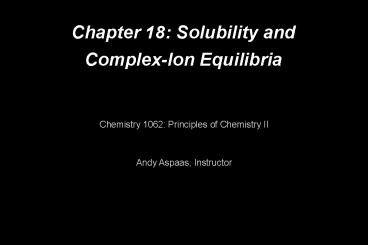Chapter 18: Solubility and Complex-Ion Equilibria - PowerPoint PPT Presentation
Title:
Chapter 18: Solubility and Complex-Ion Equilibria
Description:
An equilibrium occurs between the solid ionic compound and the dissociated ions ... Use an ICE table to find equilibrium molar concentrations of the ions (using 0 ... – PowerPoint PPT presentation
Number of Views:180
Avg rating:3.0/5.0
Title: Chapter 18: Solubility and Complex-Ion Equilibria
1
Chapter 18 Solubility andComplex-Ion Equilibria
Chemistry 1062 Principles of Chemistry II Andy
Aspaas, Instructor
2
Solubility product constant
- Excess of a slightly-soluble ionic compound is
mixed with water - An equilibrium occurs between the solid ionic
compound and the dissociated ions - CaC2O4(s) Ca2(aq) C2O42-(aq)
- Equilibrium constant for this process is called
solubility product constant, Ksp - Ksp Ca2C2O42-
- (since only aqueous components are included in
an equilibrium expression) - In the Ksp equation, raise an ions concentration
to the power of its stoichiometric number in the
chemical equation
3
Solubility and Ksp
- The solubility of silver chloride is 1.9 x 10-3
g/L. What is Ksp? - First convert the solubility to molar solubility
(mol/L) - Use an ICE table to find equilibrium molar
concentrations of the ions (using 0 as initial)
ignore the solid - Substitute concentrations into a Ksp expression
4
Solubility and Ksp
- Remember to account for the correct number of
ions forming in their molar concentrations - The solubility of Pb3(AsO4)2 is 3.0 x 10-5 g/L.
What is Ksp? - Since a single formula unit of lead arsenate
forms 3 Pb2 ions when dissolved, be sure to
multiply 3 by the molar concentration in the C
row of the ICE table
5
Calculating solubility
- What is the solubility of calcium phosphate, in
g/L? Ksp 1 x 10-26 - Create an equilibrium expression with correct
stoichiometry - In an ICE table, use x as the unknown change of
molar concentrations, multiplying stoichiometric
numbers by x - Solve for x in Ksp expression
- Convert mol/L to g/L
6
Solubility and the common-ion effect
- Addition of extra ion to a solubility equilibrium
solution will shift the equilibrium according to
Le Chateliers principle - Ex. Adding additional Ca2 to this equilibrium
- CaC2O4(s) Ca2(aq) C2O42(aq)
- This will cause the equilibrium to shift to the
left, and the solid will become less soluble
7
Common-ion effect calculation
- Compare the molar solubilities of BaF2 in pure
water and in 0.15 M NaF. Ksp 1.0 k 10-6. - Set up the water solution as before and solve for
molar solubility (x) - In the NaF solution, you have an initial
concentration of 0.15 M of F- - You can most likely assume that x ltlt 0.15 x
8
Predicting precipitation
- Recall reaction quotient, Qc
- Same calc as equilibrium constant, but system is
not necessarily at equilibrium - If Qc lt Kc, reaction goes forward
- If Qc Kc, reaction is at equilibrium
- If Qc gt Kc, reaction goes reverse
- Ion product is Qc for a solubility reaction
- Reverse means the mixture will precipitate, since
the solid dissociates in the forward direction
9
Precipitation prediction
- Ca2 0.0025 M
- C2O42- 1.0 x 10-7 M
- Will calcium oxalate precipitate? Ksp 2.3 x
10-9 - Calculate ion product
- Compare to solubility product constant































